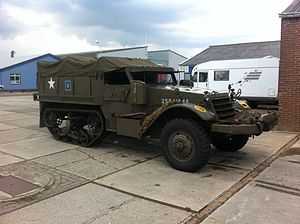M3 Half-track
| Carrier, Personnel Half-track M3 | |
|---|---|
|
An M3 half-track with .30 (7.62 mm) Browning M1919 machinegun in August 2006. | |
| Type | Half-track armored personnel carrier |
| Place of origin | United States of America |
| Specifications | |
| Weight | 9.3 t |
| Length | 6.18 m (20 ft 3 in) |
| Width | 2.22 m (7 ft 3 in) |
| Height |
2.26 m (7 ft 5 in) wheelbase 135.5 in (3.44 m)[1] |
| Crew | 3 + 10 troops |
|
| |
Main armament | 1 x 0.5 in (12.7 mm) M2 machine gun |
Secondary armament | 2 x 0.3 in (7.62 mm) M1919A4 machine guns |
| Engine |
White 160AX, 386 in3 (6,330 cc),[1] 6 cylinder, petrol, compression ratio 6.3:1,[1] 147 hp (110 kW) |
| Power/weight | 15.8 hp/tonne |
| Suspension | half track, vertical volute springs; front tread 64.5 in (1,640 mm) to 66.5 in (1,690 mm)[1] |
| Fuel capacity | 60 US gal (230 l)[1] |
Operational range | 175 mi (282 km)[1] |
| Speed | 45 mph (72 km/h)[1] |
The Carrier, Personnel Half-track M3, also known as an M3 Half-track, was an American armored vehicle widely used by the Allies during World War II and in the Cold War. Derived from the M2 Half Track Car, the slightly longer M3 was extensively produced, with about 15,000 units and more than 50,000 derivative variants manufactured.[2]
The M3 and its variants were supplied to the U.S. Army and Marines, as well as British Commonwealth and Soviet Red Army forces, serving on all fronts throughout the war.
History
Between the world wars, the U.S. Army sought to improve the tactical mobility of its forces. With the goal of finding a high-mobility infantry vehicle, the Ordnance Department had evaluated the half-track design by testing French Citroën-Kégresse vehicles. The White Motor Company produced a prototype halftrack using their own chassis and the body of the M3 Scout Car.
The design, using as many commercial components as possible to improve reliability and rate of production, was standardized in 1940 and built by the Autocar Company, Diamond T Motor Company, and the White Motor Company.
Offered with a choice of White 160AX or IHC Red Diamond 450 engines, the M3 was driven through a manual constant-mesh (non-synchromesh) transmission with four forward and one reverse gear,[1] as well as a two-speed transfer case.[1] Front suspension was leaf spring, tracks by vertical volute spring.[1] Braking was vacuum-assisted hydraulic,[1] steering manual, without power assist.[1] The electrical system was 12-volt.[1]
The M3 was the larger and longer counterpart to the M2 Half Track Car. The M2 was originally intended to function as an artillery tractor. The M3 had a single access door in the rear and seating for a 12-man rifle squad. Five seats were arranged on each side in the rear of the vehicle and three seats inside the cab.[3]
Racks under the seats were used for ammunition and rations; additional racks behind the seat backs held the squad's rifles and other stowage. A small rack for mines was added on the outside of the hull just above the tracks. In combat, most units found it necessary to stow additional food, rucksacks and other crew stowage on the outside of the vehicle. Luggage racks were often added in the field, and very late vehicles had rear-mounted racks for this crew stowage.
Early vehicles had a pintle mount just behind the front seats mounting a .50-caliber (12.7 mm) M2 Browning machine gun. The later M3A1 adopted a raised, armored 'pulpit mount' for the .50-caliber, and .30-caliber (7.62 mm) machine guns could be used from mounts along the sides of the passenger compartment. Many M3s were later modified to the M3A1 standard. The body was armored all around, with an adjustable armored shutter for the engine's radiator and a bulletproof windscreen.
The halftracks were initially extremely unpopular and dubbed "Purple Heart Boxes" (a grim reference to the US Army's decoration for combat wounds) by American troops. Chief complaints centered around the complete lack of overhead protection from airbursting artillery shells and that the armor was inadequate against machine gun fire.[4]
Total production of the M3 ran to nearly 41,000 vehicles. To supply the Allied nations International Harvester produced several thousand of a very similar vehicle, the M5 Half-track for Lend-Lease.[5]
Variants
Armored personnel carriers

- M3 – White Half-Track with White 386 in3 (6,330 cc) 160AX engine. Fitted with either an M32 anti-aircraft machine gun mount or a pedestal mount, both featuring an M2HB machine gun.
- M3A1 – Any vehicle with the improved M49 machine gun ring mount over the right hand front seat. Between 1942 and 1943 all M3 Half-Tracks (standard and A1s) were continually upgraded. These improvements included a number of drive train, engine, and stowage improvements.
- T29/M3A2 – Developed in 1943 to combine features such that existing M2 and M3 production could be switched to a common vehicle. Came at a time where the need for additional half tracks turned out to be not as great as projected. The M3A2 was, therefore, not produced.
- M3E2/M5 Half-track – International Harvester Half-Track, externally largely identical to the M3, but with 450 in3 (7,400 cc).[1][6] IHC RED-450-B engine, different drive train and fuel and electrical system.[6] In fact, only the chassis, bogies, track, idler and drive sprockets, wheels, winches, transfer case, rollers, and machine gun mount were interchangeable.[6] The M5 is heavier than the M3, due in part to heavier armor.[6] Its body was welded, rather than bolted.[6] The M5 was primarily for Lend-Lease, to Britain, Canada, France,[6] and the Soviet Union.
- M5A1 – As for the M3A1, an M5 with the M49 machine gun mount. It could fit one .50-caliber (12.7 mm) and two .30-caliber (30.06) machine guns.[6] The IHC models had a slightly lower top speed (only 42 mph (68 km/h))[1] and lower range (125 mi (201 km))[1] as well.
- T31/M5A2 – Similar in principle to the M3A2, a vehicle developed by the US Ordnance Department to combine the production of the M5 and M9 into a single vehicle. As with the M3A2, the projected need was never seen, and this version was never produced en masse.
- M9 Half-track – Same vehicle as the M5, with stowage arranged as in the M2 halftrack, with access to radios from inside (as opposed to outside) and rear doors, plus pedestal MG mount.[6]
- M9A1 – Same as M9, with ring mount and three MG pintles.[6]
Self-propelled guns

- T12/M3 75 mm GMC – M3 based Gun Motor Carriage equipped with the M1897A5 75 mm gun. These guns were fitted with the gun's M2A3 ground carriage and its gun shield. Later variants featured a purpose-built gun shield (59 rounds).[7]
- M3A1 75 mm GMC – The M2A2 gun carriage was substituted for the A3, as stocks were exhausted. Later variants featured a purpose-built gun shield.[7]
- T12 HMC – M3 based Howitzer Motor Carriage equipped with the 75 or 105 mm Pack Howitzer by the US Marine Corps.
- T48 Gun Motor Carriage – M3 based Gun Motor Carriage equipped with the M1 57 mm gun, an American copy of the British QF 6 pounder anti-tank gun. A total of 962 T48s were produced during the war. Of these, 60 were supplied under lend lease to Britain, and 650 to the USSR – who called it SU-57 (99 rounds)[8]
- T30 75 mm HMC – M3 based Howitzer Motor Carriage equipped with the M1A1 75 mm howitzer in a simple box mount (60 rounds). Used by the US Army. Also provided to the Free French Army, later used in Indochina.[9]
- T38 105 mm HMC – M3 based Howitzer Motor Carriage equipped with the M3 105 mm howitzer. Cancelled with the success of the T19.
- T19 105 mm HMC – M3 based Howitzer Motor Carriage equipped with the M2A1 105 mm howitzer (8 rounds).
- T19/M21 81 mm MMC – M3 based Motor Mortar Carriage equipped with the M1 mortar (81 mm)(97 rounds), designed to allow the mortar to be fired from within the vehicle.[10]
- T21 – M3 based mortar carrier fitted with a 4.2 inch mortar. Never adopted.
- T21E1 – The T21's mortar could only fire rearward as with the M2 based M4 MMC. The T21E1 reoriented to the mortar to fire forward.
Anti-aircraft variants
- T1E4/M13 Half-track – M3 based Multiple Gun Motor Carriage equipped with the Maxson M33 mount with two M2HB machine guns (5,000 rounds). The T1E4 prototypes had the hull sides removed for easy of working with the mount. These were reintroduced on production M13s. This was a development of previous T1s that had all been based on the M2 Half-track Car.[11]
- M14 Half-track – M13 MGMC variant, based on the M5 chassis. Supplied under lend-lease to Britain (5,000 rounds).[11]

- M16 Half-track – M3 based Multiple Gun Motor Carriage equipped with the Maxson M45 Quadmount (specifically the M45D) with four M2HB machine guns (5,000 rounds).[12]
- M16A1 MGMC – Standard M3 Personnel Carriers converted to Multiple Gun Motor Carriages by removing rear seats and installing a Maxson M45 mount (more specifically the M45F, which featured folding "bat wing" gun shields on both sides of the mount over the machine guns). These vehicles are easily identified by the lack of the folding armored hull panels found on purpose-built M16s.[12]
- M16A2 MGMC – M16 MGMC variant, basically M16s brought up to M16A1 standard and with the addition of a rear door to the hull compartment. For existing M16s, this essentially meant a replacement of the M45D mount for the M45F mount.[12]
- M17 Half-track – M16 MGMC variant, based on the M5 chassis. Sent under lend-lease to USSR (5,000 rounds).[12]
- T58 – Similar to the M16/M17, the T58 featured the Maxon quad-mount fitted to a special electric powered turret. Prototype only.
- T28E1 CGMC – M3 based Combination Gun Motor Carriage equipped with one M1A2 37 mm autocannon (240 rounds) flanked by 2 M2WC machine guns (3,400 rounds). The original T28 had been based on the shorter M2 Half-Track Car chassis.[13]
- M15 Half-track – T28E1 variant, equipped with an armored superstructure on the turreted mount to provide crew protection, and switched to M2HB machine guns.[14]
- M15A1 CGMC – Reorganization of the weapons, with the M2HB machine guns being fitted under the M1A2 37 mm autocannon instead of above as on the M15.[15]
- T10E1 – Variant to test the feasibility of mounting US made copies of the Hispano-Suiza HS.404 20 mm cannon on modified Maxson mounts. All were later rebuilt as M16s. The original T10 was based on the shorter M2 Half-Track Car chassis.
- 40 mm Experiments – Various attempts were made to mate the 40 mm Bofors L/50 gun to the M3 chassis. In all cases the weapon's recoil was too severe or the mounting too heavy, and the attempts were finally stopped with the adoption of the M19 MGMC on the M24 light tank chassis.
- T54/E1 – Tested in 1942, the gun mount quickly proved to be unstable when fired, and the improved T54E1, which also added a circular armored shield and rear armor to the vehicle, could not fix the inherent problem. Prototype only.
- T59 – A development of the T54/E1, fitted with outriggers to help stabilize the vehicle during sustained firing. Still proved to be too unstable for anti-aircraft use. Prototype only.
- T59E1 – T59 fitted with the T17 fire control system. Prototype only.
- T60/E1 – Similar to the T54 and the T59, but featured two .50 caliber M2 machine guns flanking the 40 mm cannon (the mounting's designation was T65). The T60E1 featured an armor configuration similar to that of the T54E1. Suffered from the same stability issues of previous attempts. Prototype only.
- T68 – Perhaps the most radical of the experiments, the T68 featured two 40 mm cannons, one mounted on top of the other, plus a stabilizer on top of the two guns. The recoil force proved to be too much for the mount, and the idea was abandoned. Prototype only.
- M15 "Special" – Field conversions by US Army depots in Australia of standard M3s, not M15s, fitted with turreted 40 mm Bofors L/50 guns. These were the only successful mating of this weapon to the M3 chassis, and were used more for direct fire support than for anti-aircraft purposes.
- M34" – Like the M15 "Special" above, 102 M15s were converted to M34s in Japan in 1951. The M34 mounted a single 40 mm Bofors gun in place of the M15's combination gun mount. This was due primarily to a shortage of 37 mm ammunition, which was no longer manufactured. M34s served with at least two AAA (automatic weapons) battalions (the 26th and 140th) in the Korean War.
Post-war Israeli variants

- M3 Mk. A – M5 APC. Israeli Half-Tracks were all designated M3, even M2/M9 variants and known as Zachlam זחל"ם in Hebrew. The Mk. A APCs are identified as IHC M5s by the use of RED-450 engines for the most part. While the M49 mount was retained, a variety of machine guns were used.[16]
- M3 Mk. B – M5 converted as a command carrier with extra radios and a front winch bumper. Mk. Bs featured M2HB machine guns.[16]
- M3 Mk. C – Essentially an M21 MMC, an M3 type (assumed from the common use of the White 160AX engine) Half-Track with an M1 81 mm Mortar.[16]
- M3 Mk. D – Another M3 based mortar carrier, fitted with the 120 mm Soltam mortar. Entered service in 1960.[16]
- M3 TCM-20 – M3/M5 Half-Tracks fitted with the Israeli TCM-20 armament turret with two 20 mm Hispano-Suiza HS.404 cannon fitted to old Maxson turrets. The right hand vision port was often replaced with a ball mount for a machine gun. They proved to be very effective fighting anti-tank missile teams, their cannons would at least keep the teams under cover or bother them so they could not use their missiles effectively.[17]
Current operators
Former operators
 Argentina[17]
Argentina[17].svg.png) Belgium – Belgian Army
Belgium – Belgian Army.svg.png) Brazil[18]
Brazil[18] Cambodia – Khmer National Army (FANK)
Cambodia – Khmer National Army (FANK) Canada – Canadian Army
Canada – Canadian Army Chile[18]
Chile[18] China – National Revolutionary Army
China – National Revolutionary Army Czechoslovakia[18]
Czechoslovakia[18] Cuba
Cuba Denmark – Danish Army
Denmark – Danish Army Dominican Republic – Dominican Republic Army
Dominican Republic – Dominican Republic Army France – French Army[18]
France – French Army[18].svg.png) Nazi Germany – The German Wehrmacht used captured vehicles in the north African and western fronts during World War II.
Nazi Germany – The German Wehrmacht used captured vehicles in the north African and western fronts during World War II. West Germany – West German Bundeswehr
West Germany – West German Bundeswehr Greece – Greek Army
Greece – Greek Army Israel – Israeli Defense Forces (IDF)
Israel – Israeli Defense Forces (IDF) Italy – Italian Army
Italy – Italian Army India – Indian Army
India – Indian Army.svg.png) Japan – GSDF
Japan – GSDF.svg.png) Laos – Royal Lao Army
Laos – Royal Lao Army Lebanon – Lebanese Army
Lebanon – Lebanese Army Mexico[18]
Mexico[18] The Netherlands – Dutch Army
The Netherlands – Dutch Army New Zealand
New Zealand Norway
Norway Pakistan – Pakistani Army
Pakistan – Pakistani Army Peru – Still in service, fitted with "Eyal" crane, supplied by Israel.
Peru – Still in service, fitted with "Eyal" crane, supplied by Israel..svg.png) Philippines – Philippine Army and Philippine Constabulary
Philippines – Philippine Army and Philippine Constabulary Portugal – Portuguese Army
Portugal – Portuguese Army Poland[18]
Poland[18].svg.png) South Korea – South Korean army
South Korea – South Korean army South Vietnam – Army of the Republic of Vietnam (ARVN)
South Vietnam – Army of the Republic of Vietnam (ARVN).svg.png) Soviet Union – Soviet Army[18]
Soviet Union – Soviet Army[18] Spain – Spanish Army
Spain – Spanish Army Thailand – Royal Thai Army
Thailand – Royal Thai Army Turkey – Turkish Army
Turkey – Turkish Army United Kingdom – British Army
United Kingdom – British Army United States – United States Army[19]
United States – United States Army[19] Yugoslavia – Yugoslav People's Army
Yugoslavia – Yugoslav People's Army
Non-state operators
 Amal Movement – captured from the SLA.
Amal Movement – captured from the SLA.- Hezbollah – Captured from the SLA.
- Lebanese Forces – Supplied by Israel.
- South Lebanon Army (SLA) – Supplied by Israel.
See also
- List of U.S. military vehicles by supply catalog designation
- List of U.S. military vehicles by model number
- Sd.Kfz. 251
- Sd.Kfz. 7
Citations
- ↑ 1.0 1.1 1.2 1.3 1.4 1.5 1.6 1.7 1.8 1.9 1.10 1.11 1.12 1.13 1.14 1.15 Berndt 1993, p. 152.
- ↑ Zaloga (1994), p. 42.
- ↑ army.mil, Historic M3 vehicles leave USAG Bamberg, September 30, 2013
- ↑ Zaloga (1994), p. 8.
- ↑ Zaloga (1994), p. 12.
- ↑ 6.0 6.1 6.2 6.3 6.4 6.5 6.6 6.7 6.8 Berndt 1993, p. 147.
- ↑ 7.0 7.1 Hunnicutt (2010), p. 98.
- ↑ Zaloga (1994), pp. 35–36
- ↑ Zaloga (1994), pp. 36-37
- ↑ Hunnicutt, R.P. (2010). Half-tracks: A History of American Semi-Tracked Vehicles. Santa Barbara, CA: Presidio Press. pp. 110–116.
- ↑ 11.0 11.1 Zaloga (1994), p. 38.
- ↑ 12.0 12.1 12.2 12.3 Hunnicutt (2010), pp. 123–126
- ↑ "Hit-Run Ack-Ack Guns Mounted on Half-Track" Popular Mechanics, December 1943 and "cover artwork"
- ↑ Berndt (1994), p. 33.
- ↑ Hunnicutt (2010), p. 131.
- ↑ 16.0 16.1 16.2 16.3 Zaloga (1994), p. 24.
- ↑ 17.0 17.1 "TCM-20". Weapon Systems.net. Retrieved 1 May 2015.
- ↑ 18.0 18.1 18.2 18.3 18.4 18.5 18.6 Zaloga (1994), pp. 21–22.
- ↑ Zaloga (1994), p. 3.
References
- Berndt, Thomas (1993). Standard Catalog of U.S. Military Vehicles. Iola, WI: Krause Publications. ISBN 0-87341-223-0.
- Berndt, Thomas (1994). American Tanks of World War II. Minneapolis, MN: MBI Publishing Company. ISBN 0-87938-930-3.
- Janda, Patryk (2009). Half-Track vol. I. Gdańsk, Poland: Aj-Press Publishing. ISBN 978-83-7237-207-9
- Mesko, Jim (1996). M3 Half-tracks in Action. Carrollton, TX: Squadron/Signal Publications.
- United States, Department of War (1944). TM 9-710 Basic Half-Track Vehicles (White, Autocar, and Diamond T). Washington, D.C.: Department of War.
- Zaloga, Steven J. (1994). M3 Infantry Half-Track 1940–73. Oxford, UK: Osprey Publishing.
External links
| Wikimedia Commons has media related to M3 Halftrack. |
- AFV Database
- Half-track Gets Farm Job
- M3A1 Halftrack at U.S. Veterans Memorial Museum
- WWII Vehicles – US Half tracks
- US half-tracks photo gallery at ww2photo.mimerswell.com
- FM 17-71: Crew Drill for Half-Track Vehicles
- (French) The various versions of Israeli Half-track
(Armored Command Field Manual, War Department, September 1943)
